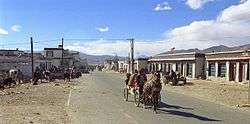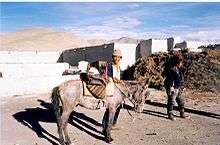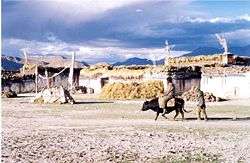Tingri (town)
| Tingri སྒང་དགའ་ | |
|---|---|
| Town | |
| Tibetan transcription(s) | |
| • Tibetan | སྒང་དགའ་ |
| • Wylie transliteration | sgang dga' |
| • IPA | [tʰìŋri] |
| Chinese transcription(s) | |
| • Simplified | 岗嘎镇 |
| • Pinyin | Gangga zhen |
 | |
 Tingri Location within Tibet | |
| Coordinates: 28°34′N 86°37′E / 28.567°N 86.617°E | |
| Country | China |
| Region | Tibet |
| Prefecture | Shigatse Prefecture |
| County | Tingri County |
| Elevation | 4,348 m (14,268 ft) |
| Population | |
| • Major Nationalities | Tibetan |
| • Regional dialect | Tibetan language |
| Time zone | +8 |
Gangga (or Tingri according to name of region) (Tibetan: སྒང་དགའ་, Wylie: sgang dga', Chinese: 岗嘎镇; Pinyin: Gangga zhen)[1] is a town in southern Tibet. It is in Tingri County, Shigatse Prefecture with a population of around 523. It is often used as a base by mountain climbers preparing to ascend Mount Everest or Cho Oyu. Tingri Shelkar (Dring ri Shel dkar) is a small town approximately 60 km north-west of Mount Everest and just over 50 km from the Nepali border in the Tibet Autonomous Region of China. It is at an altitude of about 4,300 metres (approx. 14,107 feet). The old Shekar Dorje Dzong, or fort, is above the new town and used to enclose Shekar Chode, a Gelug monastery which was completely destroyed but is being restored.[2] It is known for its spectacular views of Mount Everest, Mount Lhotse, Mount Makalu, and Cho Oyu, which comprise four of the six highest mountains in the world.

Tingri used to be an important trading post where Sherpas from Nepal exchanged rice, grain and iron for Tibetan wool. livestock and salt. It gives its name to the broad upland basin more than 4,500 metres high that is known as the Tingri Plain. One must cross the pass known as the Lakpa La (5,220 m) to the north to reach the Tsangpo Valley system. Shallow, fast-flowing rivers of melted snow water make its grassy meadowland ideal for grazing by Tibetan animals. The plain used to abound with gazelles, blue sheep, antelopes and khyang or wild asses but, unfortunately, most of the animals are gone now.[3] The Chinese army has a small base nearby.


.jpg)

Tingri Lankor (Ding ri glang 'khor) — Padampa's Residence was founded in 1097 CE by the South Indian Buddhist adept, Padampa Sangye (died 1117) who made five visits to Tibet and was an important person in the re-establishment of the Buddhadharma in Tibet. His consort was the famous Tibetan dakini Machik Labdron. The gompa or temple was built in the Padampa Sange's meditation cave and became the seat of the Dampapa School of Tibetan Buddhism. It is in the process of restoration.[4]
Footnotes
- ↑ Strachey 1854, p. 4.
- ↑ Dowman 1998, p. 280.
- ↑ Buckley & Strauss 1986, pp. 193, 196.
- ↑ Dowman 1998, p. 281.
References
- Buckley, Michael; Strauss, Robert (1986). Tibet: a travel survival kit. Lonely Planet. ISBN 0-908086-88-1.
- Dowman, Keith (1998). The Power-Places of Central Tibet: The Pilgrim's Guide. London: Routledge & Kegan Paul Ltd. ISBN 0-7102-1370-0.
- Strachey, Henry (1854). "Physical Geography of Western Tibet". Journal of the Royal Geographical Society. XXIII: 1–69, plus map. ISSN 0266-6235.
External links
| Wikimedia Commons has media related to Tingri. |
